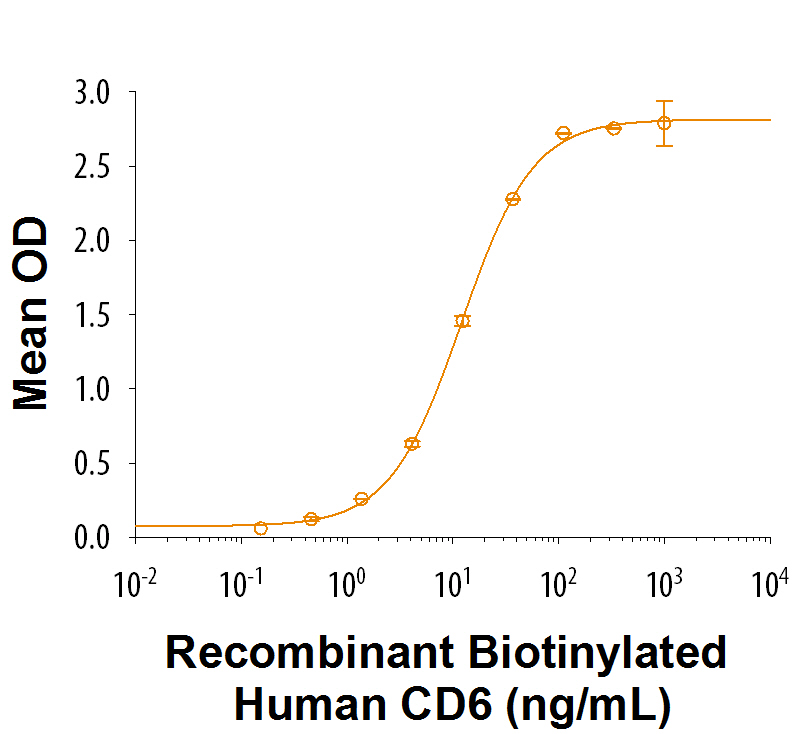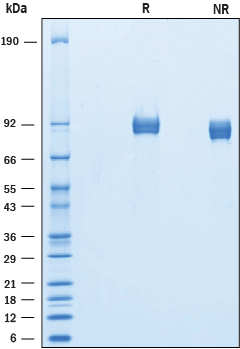Recombinant Mouse ALCAM His-tag Protein, CF Summary
Product Specifications
Trp28-Lys527, with a C-terminal 6-His tag
Analysis
Product Datasheets
Carrier Free
CF stands for Carrier Free (CF). We typically add Bovine Serum Albumin (BSA) as a carrier protein to our recombinant proteins. Adding a carrier protein enhances protein stability, increases shelf-life, and allows the recombinant protein to be stored at a more dilute concentration. The carrier free version does not contain BSA.
In general, we advise purchasing the recombinant protein with BSA for use in cell or tissue culture, or as an ELISA standard. In contrast, the carrier free protein is recommended for applications, in which the presence of BSA could interfere.
10012-AL
| Formulation | Lyophilized from a 0.2 μm filtered solution in PBS. |
| Reconstitution | Reconstitute at 500 μg/mL in PBS. |
| Shipping | The product is shipped at ambient temperature. Upon receipt, store it immediately at the temperature recommended below. |
| Stability & Storage: | Use a manual defrost freezer and avoid repeated freeze-thaw cycles.
|
Scientific Data
 View Larger
View Larger
When Recombinant Mouse ALCAM/CD166 is immobilized at 1 μg/mL, Recombinant Biotinylated Human CD6 Fc Chimera binds with an ED50 of 6-36 ng/mL.
 View Larger
View Larger
2 μg/lane of Recombinant Mouse ALCAM/CD166 was resolved with SDS-PAGE under reducing (R) and non-reducing (NR) conditions and visualized by Coomassie® Blue staining, showing bands at 81-95 kDa.
Reconstitution Calculator
Background: ALCAM/CD166
ALCAM (activated leukocyte cell adhesion molecule), designated CD166 and also called MEMD and SC-1/DM-GRASP/BEN in the chicken, is a 100-110 kDa type I transmembrane glycoprotein and a member of the Ig CAM family within the immunoglobulin superfamily (1). ALCAM is expressed on thymic epithelium, microvascular endothelium, activated lymphocytes and monocytes, and monocyte derived dendritic cells (1, 2). Mouse ALCAM cDNA encodes 583 amino acid (aa), including signal peptide (27 aa), extracellular domain (ECD, 500 aa) with two V-type and three C2-type Ig-like domains, transmembrane (22 aa) and cytoplasmic (34 aa) domains (1). Mouse ALCAM ECD shares 98%, 93%, and 92% aa sequence identity with rat, human/porcine and bovine/equine ALCAM, respectively. A secreted isoform in endothelial cells that is truncated at aa 133 (sALCAM) antagonizes full‑length ALCAM (3, 4). ALCAM mediates low affinity adhesion with itself or the cysteine-rich scavenger receptor CD6 to regulate T cell development, immunological synapses (IS), and cell migration through endothelial junctions (1-11). ALCAM on thymic epithelia mediates adhesion to CD6 on CD4+CD8+ T cells (6). Adhesion of ALCAM-expressing antigen presenting cells and CD6-expressing T cells stabilizes the early IS, while later it enhances CD3 effects on T cell proliferation, CD25 expression, and Th1 commitment (2, 7, 8). High ALCAM expression at the blood brain barrier in active multiple sclerosis, and its mouse model (EAE), promotes leukocyte migration to the brain (8, 9). High ALCAM expression on melanoma cell lines appears to be pro-metastatic, but anti-metastatic activity has been reported in breast cancer (3, 10, 11). ALCAM may influence expression or adhesion of the neuronal adhesion molecule NCAM-L1, both in the developing retina and invasive melanoma (3, 12). It may also play a role in stabilizing cell-cell interaction among lymphatic endothelial cells (LECs) and affecting the organization and function of the lymphatic vessel (LV) network (13).
- Bowen, M.A. et al. (1995) J. Exp. Med. 181:2213.
- Zimmerman, A.W. et al. (2006) Blood 107:3212.
- van Kilsdonk, J.W.J. et al. (2008) Cancer Res. 68:3671.
- Ikeda, K. and T. Quertermous (2004) J. Biol. Chem. 279:55315.
- van Kempen, L.C. et al. (2001) J. Biol. Chem. 276:25783.
- Castro, M.A.A. et al. (2007) J. Immunol. 178:4351.
- Nair, P. et al. (2010) Clin. Exp. Immunol. 162:116.
- Masedunskas, A. et al. (2006) FEBS Lett. 580:2637.
- Cayrol, R. et al. (2008) Nat. Immunol. 9:137.
- Degen, W.G. et al. (1998) Am. J. Pathol. 152:805.
- King, J.A. et al. (2010) Mol. Cancer 9:266.
- Buhusi, M. et al. (2009) J. Neurosci. 29:15630.
- Iolyeva M. et al. (2013) FASEB J. 27:978.
FAQs
No product specific FAQs exist for this product, however you may
View all Proteins and Enzyme FAQsReviews for Recombinant Mouse ALCAM His-tag Protein, CF
There are currently no reviews for this product. Be the first to review Recombinant Mouse ALCAM His-tag Protein, CF and earn rewards!
Have you used Recombinant Mouse ALCAM His-tag Protein, CF?
Submit a review and receive an Amazon gift card.
$25/€18/£15/$25CAN/¥75 Yuan/¥1250 Yen for a review with an image
$10/€7/£6/$10 CAD/¥70 Yuan/¥1110 Yen for a review without an image


